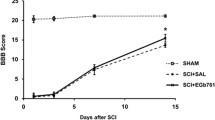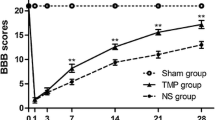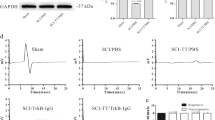Abstract
In this study, we studied the effect of triptolide (TPL) on locomotor function in rats with spinal cord injury. A total of 40 rats were studied after dividing them in two major groups, one was experimental group denoted as TPL group while other was control group denoted as PBS group. Each group was subdivided in four subgroups having five rats each (n = 5). TPL was given intraperitonially at the rate of 5 mg/kg/day in TPL group while PBS was given at the same time interval in the same manner in control group for comparison. A reduction in the cavity area of tissue sections was observed by bright field microscopy from 0.22 ± 0.05 to 0.12 ± 0.05 mm2 in experimental group after 28 days of treatment while BBB score also improved from 1 to 5 after 14 days of treatment. SPSS software, one way ANOVA, was used for recording statistical analysis and values were expressed as mean ± SEM where P value of <0.01 was considered significant. The expression of I-kBα and NF-kB p65 was also studied using western blotting and after recording optical density (OD) values of western blots. It was observed that treatment with TPL significantly reduced the expression of these factors after 28 days of treatment compared with controls.







Similar content being viewed by others

References
Chen BJ (2001) Triptolide, a novel immunosuppressive and anti-inflammatory agent purified from a Chinese herb Tripterygium wilfordii Hook F. Leuk Lymphoma 42:253–265
Qiu D, Kao PN (2003) Immunosuppressive and anti-inflammatory mechanisms of triptolide, the principal active diterpenoid from the Chinese medicinal herb Tripterygium wilfordii Hook. f. Drugs R D 4:1–18
Brinker AM, Ma J, Lipsky PE, Raskin I (2007) Medicinal chemistry and pharmacology of genus Tripterygium (Celastraceae). Phytochemistry 68:732–766
Yu DY (1983) Clinical observation of 144 cases of rheumatoid arthritis treated with glycoside of Radix Tripterygium Wilfordii. J Tradit Chin Med 3:125–129
Pan J (2010) RNA polymerase—an important molecular target of triptolide in cancer cells. Cancer Lett 292:149–152
Tao X, Lipsky PE (2000) The Chinese anti-inflammatory and immunosuppressive herbal remedy Tripterygium wilfordii Hook. f. Rheum Dis Clin North Am 26:29–50
Takaishi Y, Ujita K, Tokuda H, Nishino H, Iwashima A, Fujita T (1992) Inhibitory effects of dihydroagarofuran sesquiterpenes on Epstein–Barr virus activation. Cancer Lett 65:19–26
Li XY (1993) Anti-inflammatory and immunosuppressive components of Tripterygium wilfordii Hook. f. Int J Immunother 9:181–187
Blight AR (1992) Macrophages and inflammatory damage in spinal cord injury. J Neurotrauma 9:83–91
Dusart I, Schwab ME (1993) Secondary cell death and the inflammatory reaction after dorsal hemisection of the rat spinal cord. Eur J Neurosci 6:712–724
Popovic PG, Reinhard J, Flanagan EM, Stokes BT (1994) Elevation of the neurotoxin quinolinic acid occurs following spinal cord trauma. Brain Res 633:348–352
Baeuerle PA (1991) The inducible transcription activator NF-kB: regulation by distinct protein subunits. Biochim Biophys Acta 1072:63–80
Baeuerle PA, Henkel T (1994) Function and activation of NF-kB in the immune system. Annu Rev Immunol 12:141–179
Brambilla R, Bracchi-Ricard V, Hu WH, Frydel B, Bramwell A, Karmally S, Green EJ, Bethea JR (2005) Inhibition of astroglial nuclear factor kappaB reduces inflammation and improves functional recovery after spinal cord injury. J Exp Med 202:145–156
Rafati DS, Geissler K, Johnson K, Unabia G, Hulsebosch C, Nesic-Taylor O, Perez-Polo JR (2008) Nuclear factor-kappaB decoy amelioration of spinal cord injury-induced inflammation and behavior outcomes. J Neurosci Res 86:566–580
Pandey MK, Sandur SK, Sung B, Sethi G, Kunnumakkara AB, Aggarwal BB (2007) Butein, a tetrahydroxychalcone, inhibits nuclear factor (NF)-kappaB and NF-kappaB-regulated gene expression through direct inhibition of IkappaBalpha kinase beta on cysteine 179 residue. J Biol Chem 282:17340–17350
Yadav VR, Prasad S, Sung B, Aggarwal BB (2011) The role of chalcones in suppression of NF-kappaB-mediated inflammation and cancer. Int Immunopharmacol 11:295–309
Beck KD, Nguyen HX, Galvan MD, Salazar DL, Woodruff TM, Anderson AJ (2010) Quantitative analysis of cellular inflammation after traumatic spinal cord injury: evidence for a multiphasic inflammatory response in the acute to chronic environment. Brain 133:433–447
Sribnick EA, Wingrave JM, Matzelle DD, Wilford GG, Ray SK, Banik NL (2005) Estrogen attenuated markers of inflammation and decreased lesion volume in acute spinal cord injury in rats. J Neurosci Res 82:283–293
Studer L, Tabar V, McKay RD (1998) Transplantation of expanded mesencephalic precursors leads to recovery in Parkinsonian rats. Nat Neurosci 1:290–295
Han X, Wang SY, Zhang Z, Lü DC, Liu HR (2011) BMS-345541 inhibited nuclear factor kappa B expression and improved locomotor function recovery in rats after acute spinal cord injury. Neural Regen Res 6:1775–1779
Wu SX, Guo NR (2005) Clinical observation on effect of triptolide tablet in treating patients with psoriasis vulgaris. Chin J Integr Med 11:147–148
Liu Q (2011) Triptolide and its expanding multiple pharmacological functions. Int Immunopharmacol 11:377–383
Lenzlinger PM, Morganti-Kossmann MC, Laurer HL, McIntosh TK (2001) The duality of the inflammatory response to traumatic brain injury. Mol Neurobiol 24:169–181
Jiao J, Xue B, Zhang L, Gong Y, Li K, Wang H, Jing L, Xie J, Wang X (2008) Triptolide inhibits amyloid β1-42-induced TNF-α and IL-1β production in cultured rat microglia. J Neuroimmunol 205:32–36
Zhou HF, Niu DB, Xue B, Li FQ, Liu XY, He QH, Wang XH, Wang XM (2003) Triptolide inhibits TNF-α, IL-1β and NO production in primary microglial cultures. Neuroreport 14:1091–1095
Su Z, Yuan Y, Cao L, Zhu Y, Gao L, Qiu Y, He C (2010) Triptolide promotes spinal cord repair by inhibiting astrogliosis and inflammation. Glia 58:901–915
Tsuchiya D, Hong S, Matsumori Y, Kayama T, Swanson RA, Dillman WH, Liu J, Panter SS, Weinstein PR (2003) Overexpression of rat heat shock protein 70 reduces neuronal injury after transient focal ischemia, transient global ischemia, or kainic acid-induced seizures. Neurosurgery 53:1179–1187
Conti A, Cardali S, Genovese T, Di Paola R, La Rosa G (2003) Role of inflammation in the secondary injury following experimental spinal cord trauma. J Neurosurg Sci 47:89–94
Conflict of interest
None.
Author information
Authors and Affiliations
Corresponding author
Additional information
Following an internal investigation, this article is retracted at the author's request and in consent with the Editor-in-Chief due to similarities in Figures 1, 4, 6 in Neurological Sciences, and Figures 1, 6 and 4 respectively in the paper by Chong Xun, et al. "Study of Effect of Salvianolic Acid B on Motor Function Recovery in Rats with Spinal Cord Injury", published in BioMed Research International, Volume 2014, Article ID 931850.
An erratum to this article is available at http://dx.doi.org/10.1007/s10072-017-2837-5.
About this article
Cite this article
Wang, B., Chen, C., Zhang, JT. et al. RETRACTED ARTICLE: Triptolide (TPL) improves locomotor function recovery in rats and reduces inflammation after spinal cord injury. Neurol Sci 36, 701–705 (2015). https://doi.org/10.1007/s10072-014-2001-4
Received:
Accepted:
Published:
Issue Date:
DOI: https://doi.org/10.1007/s10072-014-2001-4



